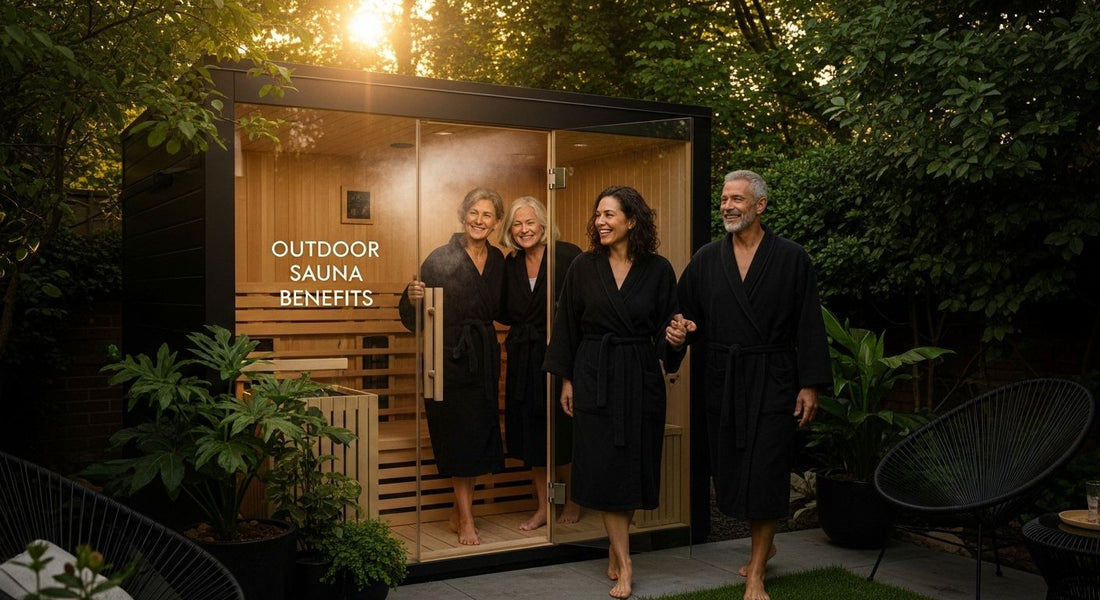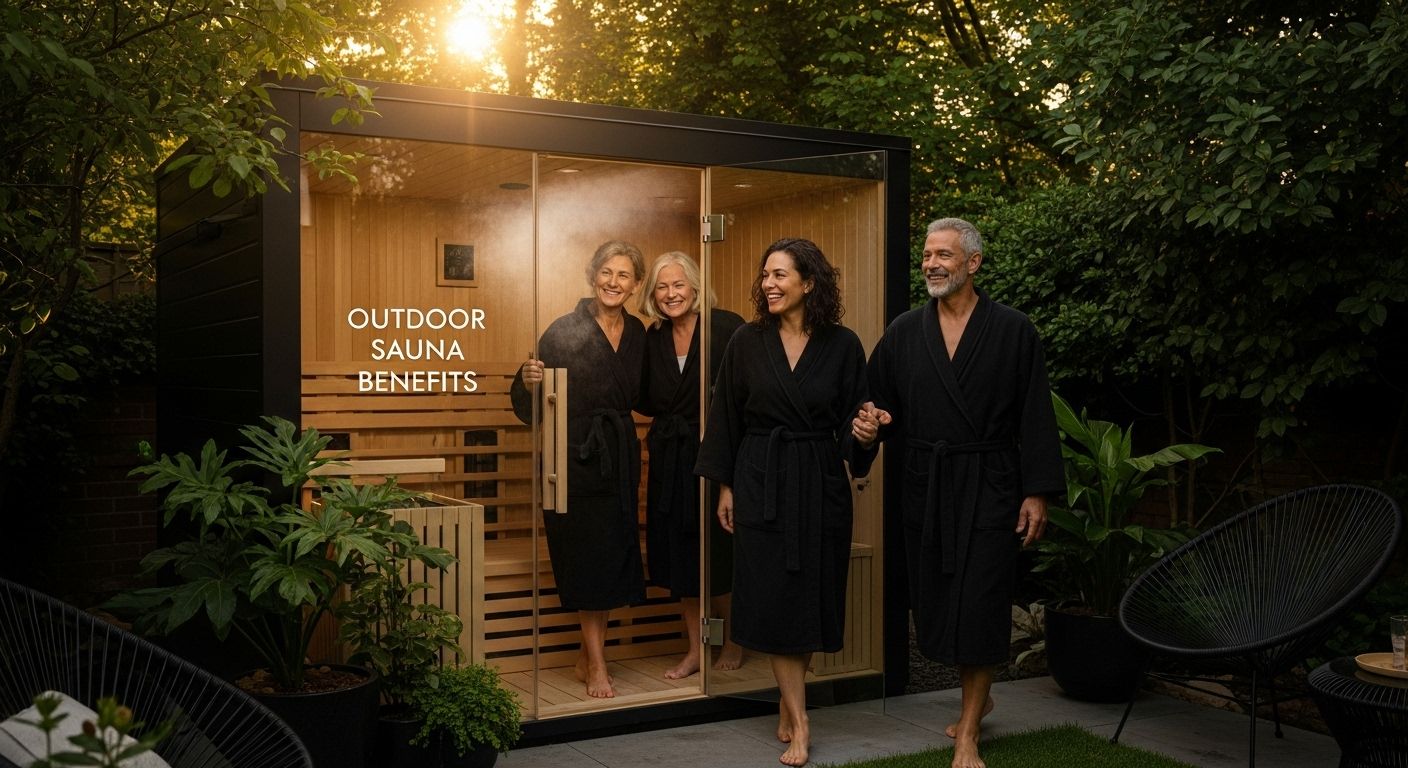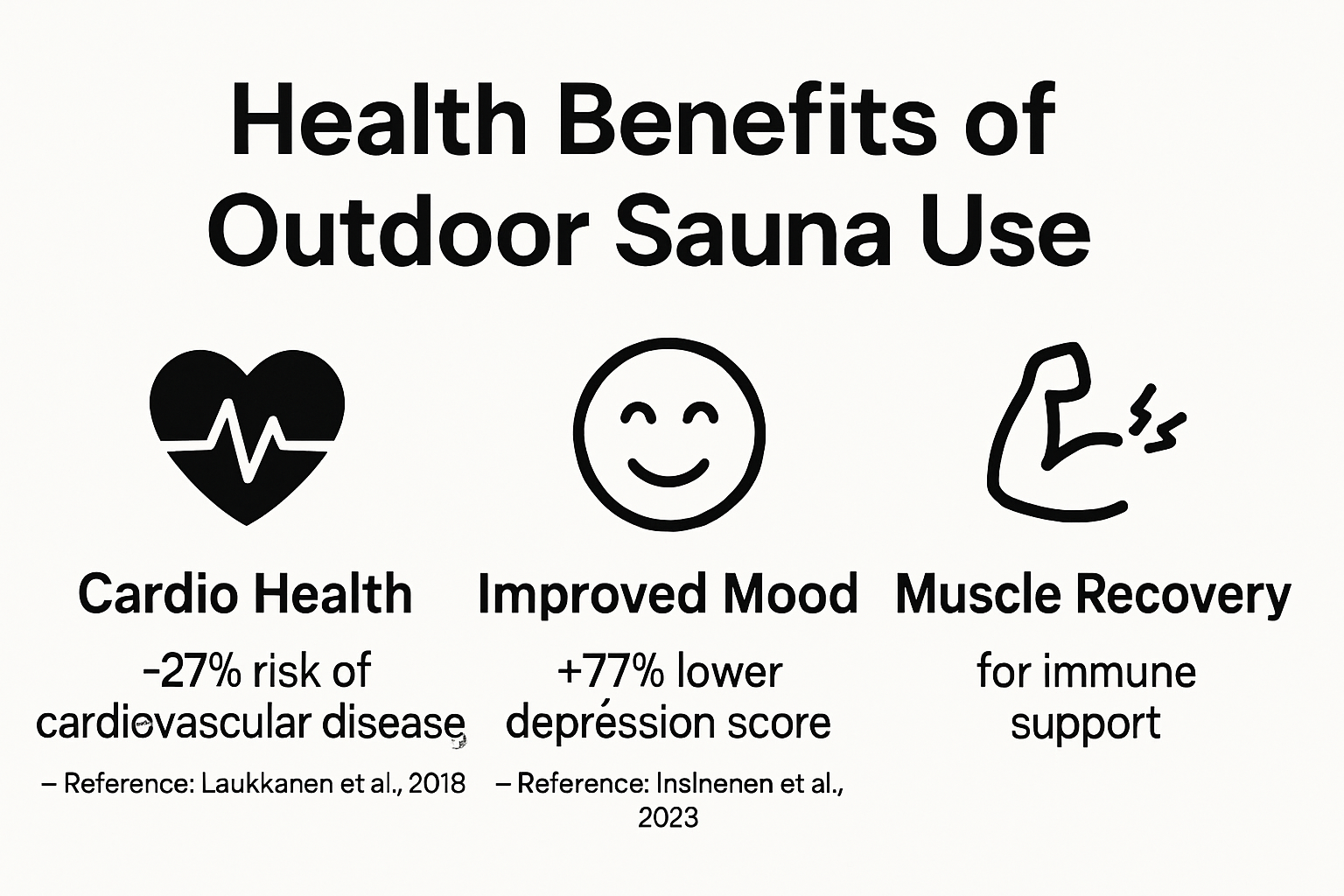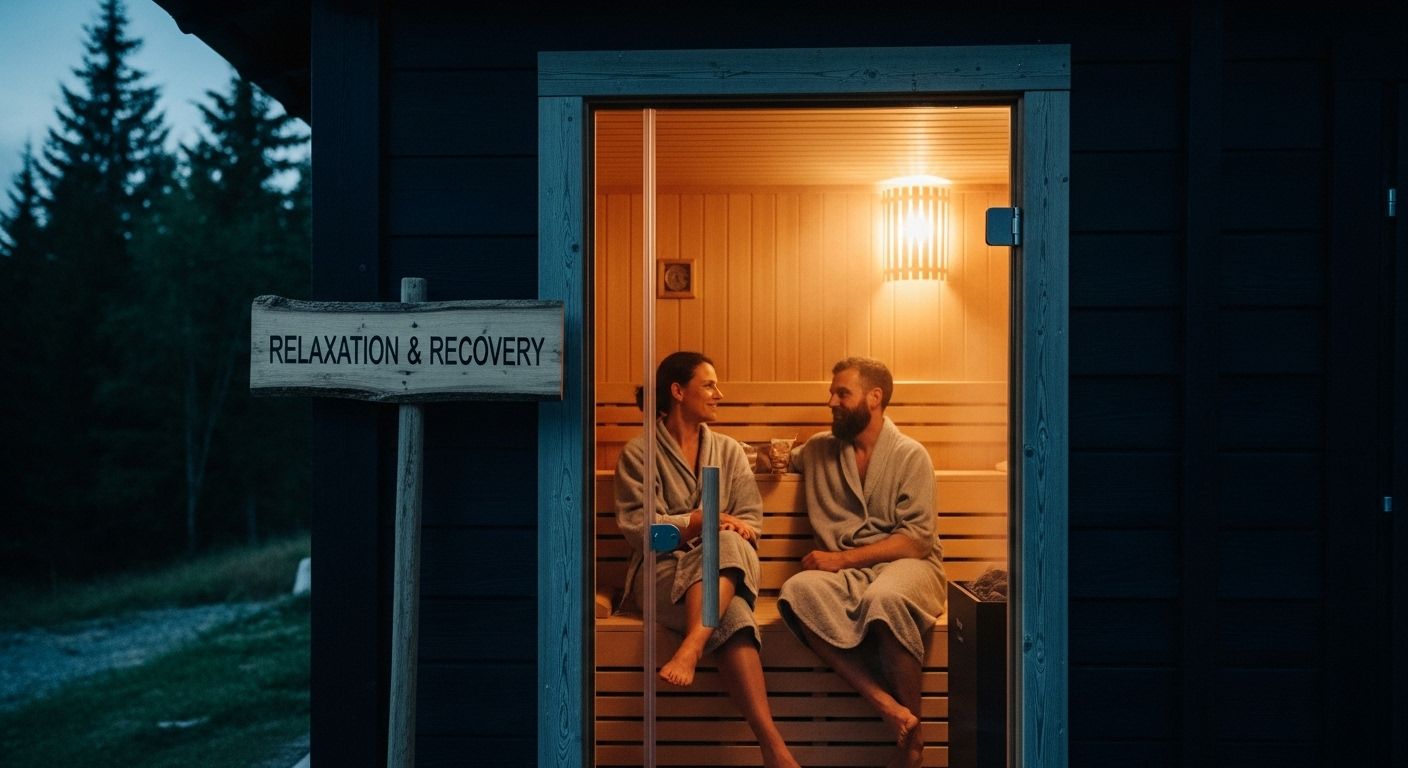
Understanding Outdoor Sauna Benefits for Health and Relaxation
Outdoor saunas are popping up in backyards everywhere and people are catching on to their powerful health perks. Here is something most folks miss. Regular sauna sessions can lower the risk of deadly heart disease by up to 63 percent according to recent medical studies. That sounds impressive and relaxing, right? But the way these saunas actually work goes way beyond just heat and steam. The science behind them might surprise you.

Table of Contents
- What Is An Outdoor Sauna And How Does It Work?
- The Health Benefits Of Regular Sauna Use
- Why Outdoor Saunas Promote Better Relaxation And Recovery
- The Science Behind Saunas: How Heat Therapy Works
- Integrating Outdoor Saunas Into A Healthy Lifestyle
Quick Summary
| Takeaway | Explanation |
|---|---|
| Consistent sauna use benefits health | Regular sauna sessions improve cardiovascular health, reduce stress, and boost metabolism, promoting overall well-being. |

| Outdoor setting enhances relaxation | The natural environment combined with heat therapy amplifies mental rejuvenation and reduces stress levels more effectively than indoor spaces. | | Start with short sauna sessions | Beginners should begin with 10-15 minute sessions, gradually increasing duration as their bodies adapt to heat exposure. | | Combine sauna with healthy lifestyle practices | Integrate sauna use with proper nutrition, hydration, and regular exercise for maximum health benefits and improved recovery. | | Sauna supports preventative health strategies | Regular heat exposure may reduce risks of cardiovascular diseases and enhance immune function, contributing to long-term health maintenance. |
What is an Outdoor Sauna and How Does It Work?
An outdoor sauna is a dedicated wellness space designed to provide therapeutic heat exposure outside of traditional indoor settings. Unlike interior saunas, these structures are specifically built to withstand external environmental conditions while delivering comprehensive health benefits. Harvard Health explains that saunas generate high temperatures that trigger significant physiological responses in the human body.
The Basic Structure and Design
Outdoor saunas are typically constructed using durable, weather-resistant materials like cedar, spruce, or thermally modified wood that can endure various climate conditions. These structures range from compact prefabricated units to custom-built rooms featuring robust insulation and specialized heating elements. The primary goal is creating an enclosed space capable of reaching temperatures between 150F and 195F with controlled humidity levels.
To help you understand how outdoor saunas differ from indoor saunas and what makes them unique, here is a comparison of their main structural and functional characteristics:
| Feature | Outdoor Saunas | Indoor Saunas |
|---|---|---|
| Location | Installed outside, exposed to natural environment | Installed inside homes or fitness centers |
| Construction Materials | Weather-resistant wood (cedar, spruce, thermally modified) | Standard wood suitable for interiors |
| Protection/Insulation | Designed for moisture and temperature fluctuations | Minimal weather protection needed |
| Heating Methods | Electric, wood-burning, or infrared | Electric or infrared, less commonly wood-burning |
| Ventilation | Integrated outdoor ventilation systems | Indoor air circulation systems |
| Temperature Range | 150F - 195F | 150F - 195F |
| Humidity Control | Can feature adjustable ventilation and humidity levels | Typically more controlled and less variable |
Key design characteristics include:
- Solid wood construction with tight seal against external elements
- Ventilation systems for air circulation
- Integrated heating mechanisms (electric, wood-burning, or infrared)
- Exterior finish protecting against moisture and temperature fluctuations
Physiological Mechanisms of Heat Exposure
The therapeutic power of outdoor saunas lies in their ability to induce controlled heat stress. According to Cleveland Clinic, when exposed to high temperatures, the human body initiates complex physiological responses. Your skin temperature rises rapidly, causing blood vessels to dilate and increase circulation. This process triggers sweating, which helps eliminate toxins and promotes cardiovascular conditioning.
As your body works to cool itself, heart rate increases similar to moderate exercise, delivering potential benefits like improved cardiovascular function, stress reduction, and enhanced metabolic performance. The controlled heat environment stimulates endorphin production, creating a natural relaxation response that supports both physical and mental wellness.
The Health Benefits of Regular Sauna Use
Regular sauna use offers a comprehensive range of health benefits that extend far beyond simple relaxation. By subjecting the body to controlled heat exposure, individuals can experience significant physiological improvements across multiple health domains. Mayo Clinic Proceedings highlights that consistent sauna bathing is associated with remarkable long-term wellness outcomes.
Below is a summary of the main health benefits of regular outdoor sauna use, organized by benefit and its key effects described in the article:
| Health Benefit | Key Effects and Outcomes |
|---|---|
| Cardiovascular Health | Improved circulation, reduced blood pressure, enhanced heart function, lower risk of heart disease |
| Stress Reduction | Lowered cortisol, increased endorphins, improved mood, better sleep |
| Metabolic Support | Increased metabolism, faster sweating, cellular repair |
| Immune System Boost | Higher white blood cell production, enhanced infection resistance, reduced inflammation |
| Muscle Recovery | Increased blood flow to muscles, faster healing, reduced soreness |
| Psychological Wellness | Deeper relaxation, improved emotional regulation, heightened mental clarity |
Cardiovascular Health and Circulation
Sauna sessions trigger profound cardiovascular responses that mimic moderate exercise. When exposed to high temperatures, blood vessels dilate, improving overall circulation and reducing peripheral resistance. This natural response helps lower blood pressure, enhance heart function, and promote more efficient blood flow throughout the body.
Key cardiovascular benefits include:
- Improved arterial flexibility
- Reduced risk of hypertension
- Enhanced heart muscle performance
- Potential reduction in cardiovascular disease risk
Stress Reduction and Mental Wellness
The therapeutic heat environment of saunas stimulates significant neurological and hormonal changes. As body temperature rises, the brain releases endorphins and reduces cortisol levels, creating a powerful stress management mechanism. Regular sauna use can help individuals manage anxiety, improve mood stability, and promote deeper relaxation.
The mental health benefits are particularly noteworthy, with potential impacts on:
- Decreased stress hormone production
- Improved sleep quality
- Enhanced mental clarity
- Natural mood elevation
Metabolic and Immune System Support
Sauna sessions act as a powerful metabolic stimulant, increasing core body temperature and triggering sweating. This process activates multiple physiological mechanisms that support overall health. The induced heat stress promotes cellular repair, boosts metabolism, and strengthens immune system responses. Some research suggests that regular sauna use can increase white blood cell production, potentially improving the body’s ability to fight infections and inflammatory conditions.
Why Outdoor Saunas Promote Better Relaxation and Recovery
Outdoor saunas offer a unique environment that amplifies relaxation and recovery beyond traditional indoor wellness spaces. By integrating natural surroundings with therapeutic heat exposure, these wellness sanctuaries create a holistic approach to physical and mental restoration. Evidence-Based Complementary and Alternative Medicine highlights the profound impact of sauna bathing on stress reduction and physiological recovery.
Neurological and Physiological Relaxation Mechanisms
The combination of outdoor settings and heat exposure triggers complex neurological responses that promote deep relaxation. When the body experiences controlled heat stress, the parasympathetic nervous system activates, reducing cortisol levels and stimulating the production of feel-good neurotransmitters. This natural process helps transition the body from a state of tension to profound calmness.
Significant neurological relaxation benefits include:
- Reduced sympathetic nervous system activity
- Enhanced production of endorphins
- Decreased stress hormone circulation
- Improved overall emotional regulation
Physical Recovery and Muscle Restoration
Outdoor saunas create an optimal environment for muscle recovery and physical restoration. The elevated temperatures increase blood circulation, delivering oxygen and nutrients more efficiently to stressed muscle groups. This enhanced blood flow accelerates healing processes, reduces inflammation, and helps alleviate muscle soreness after intense physical activities.
Key physical recovery advantages comprise:
- Accelerated muscle tissue repair
- Reduced post-exercise inflammation
- Enhanced metabolic waste elimination
- Improved flexibility and muscle elasticity
Natural Environment and Psychological Wellness
The outdoor setting of these saunas introduces an additional layer of psychological benefits. Surrounded by natural elements, individuals experience a more immersive relaxation experience. The combination of controlled heat and natural scenery helps lower psychological barriers, reduces mental fatigue, and promotes a deeper sense of connection with the surrounding environment. This holistic approach to wellness supports not just physical recovery, but comprehensive mental rejuvenation.

The Science Behind Saunas: How Heat Therapy Works
Heat therapy represents a sophisticated physiological intervention that leverages controlled temperature exposure to trigger complex bodily responses. Saunas function as precise instruments of thermal stimulation, creating a controlled environment that challenges and enhances human physiological systems. Mayo Clinic Proceedings reveals that systematic heat exposure produces remarkable biological transformations across multiple health domains.
Thermoregulatory Response and Cardiovascular Adaptation
When entering a sauna, the human body initiates an intricate thermoregulatory process designed to maintain core temperature stability. As ambient temperatures rise, blood vessels dilate, increasing peripheral blood flow and reducing cardiovascular resistance. This natural response mimics moderate cardiovascular exercise, causing heart rate to elevate and metabolic processes to accelerate.
Key cardiovascular adaptation mechanisms include:
- Increased cardiac output
- Enhanced blood vessel elasticity
- Improved peripheral circulation
- Accelerated metabolic performance
Cellular Stress Response and Protein Activation
Heat exposure triggers a profound cellular defense mechanism known as hormesis, where mild stress stimulates protective biological processes. Elevated temperatures activate heat shock proteins, molecular chaperones that help protect cells from damage and support protein folding. This cellular stress response strengthens cellular resilience and potentially supports long-term metabolic health.
Significant cellular adaptation responses comprise:
- Activation of heat shock protein production
- Enhanced cellular repair mechanisms
- Improved protein stability
- Potential reduction in inflammation markers
Neurological and Endocrine System Modulation
Sauna sessions profoundly influence neurological and hormonal systems by stimulating neurotransmitter release and modulating stress-related hormones. The controlled heat environment prompts the brain to release endorphins while simultaneously reducing cortisol levels, creating a unique neurochemical balance that supports mental and emotional wellness. This delicate hormonal recalibration contributes to improved stress management and potentially supports overall psychological resilience.
Integrating Outdoor Saunas into a Healthy Lifestyle
Integrating outdoor saunas into a comprehensive wellness routine offers a holistic approach to personal health management. By strategically incorporating heat therapy into daily life, individuals can unlock multiple physiological and psychological benefits. Mayo Clinic Proceedings emphasizes that consistent sauna practice can significantly enhance overall well-being when approached mindfully.
Establishing a Sustainable Sauna Routine
Successful integration requires developing a consistent and personalized sauna practice that aligns with individual fitness and wellness goals. Start by determining an appropriate frequency and duration that complements existing health routines. Most health professionals recommend beginning with shorter sessions of 10-15 minutes, gradually increasing duration as the body adapts to heat exposure.
Key considerations for developing a sustainable routine include:
- Starting with shorter, more frequent sessions
- Monitoring personal comfort and hydration levels
- Listening to body signals and avoiding overexertion
- Consulting healthcare professionals for personalized guidance
Complementary Wellness Strategies
Outdoor saunas work most effectively when integrated with other healthy lifestyle practices. Combine sauna sessions with balanced nutrition, regular exercise, and proper hydration to maximize physiological benefits. The synergy between heat therapy and other wellness strategies can amplify overall health improvements, supporting cardiovascular function, stress reduction, and metabolic efficiency.
Optimal complementary wellness approaches involve:
- Maintaining consistent hydration before and after sauna use
- Pairing sauna sessions with light stretching or meditation
- Supporting heat therapy with nutrient-rich, anti-inflammatory diets
- Practicing mindful recovery techniques
Long-Term Health and Preventative Wellness
Regular outdoor sauna use transcends immediate relaxation, positioning itself as a proactive health management strategy. By consistently exposing the body to controlled heat stress, individuals can potentially reduce risks associated with cardiovascular diseases, support immune function, and promote cellular resilience. The cumulative effect of systematic sauna practice represents a powerful approach to preventative wellness, emphasizing holistic health maintenance rather than reactive treatment.
Experience the Benefits of Outdoor Saunas in Your Own Backyard
Are you ready to transform stress, sore muscles, and daily fatigue into real wellness and complete relaxation? The article has shown how outdoor saunas help you achieve healthier circulation, stronger recovery, and a calmer mind by harnessing both nature and therapeutic heat. If you want authentic results at home, explore how Best Life Sauna can help you put this science into practice with premium outdoor and traditional sauna solutions. Discover more at Best Life Sauna and find out what sets us apart.

Now is the ideal moment to invest in your health. Upgrade your space with a quality outdoor sauna or browse our wellness products like cold plunge tubs, hot tubs, and accessories for all-around recovery. With customer service you can count on, free shipping on most orders, and proven satisfaction from real users, Best Life Sauna gives you the confidence to start your wellness journey today.
Frequently Asked Questions
What are the health benefits of using an outdoor sauna?
Regular use of an outdoor sauna offers several health benefits, including improved cardiovascular health, enhanced circulation, stress reduction, and boosted immune system function. It also promotes muscle recovery and relaxation.
How does an outdoor sauna help with relaxation?
An outdoor sauna creates an ideal environment for relaxation by combining therapeutic heat exposure with natural surroundings. This unique setting reduces cortisol levels and increases endorphin production, leading to improved mood and stress management.
What types of heating methods are available for outdoor saunas?
Outdoor saunas typically use electric, wood-burning, or infrared heating methods. Each type has its own benefits, with electric options providing consistent temperatures, wood-burning offering traditional experiences, and infrared promoting deeper heat penetration.
To clarify the differences among the main types of outdoor sauna heating methods mentioned, here is a simple comparison table:
| Heating Method | Description | Key Benefits |
|---|---|---|
| Electric | Uses electric heater to produce consistent heat | Easy to control, low maintenance |
| Wood-Burning | Burns wood to provide traditional sauna experience | Authentic ambiance, natural heat and aroma |
| Infrared | Utilizes infrared panels to deliver radiant heat | Deeper heat penetration, energy efficient |
How often should I use my outdoor sauna for optimal health benefits?
For optimal health benefits, it is recommended to use an outdoor sauna several times a week. Beginners should start with shorter sessions of 10-15 minutes, gradually increasing duration as they adapt to the heat, while ensuring they stay hydrated.

